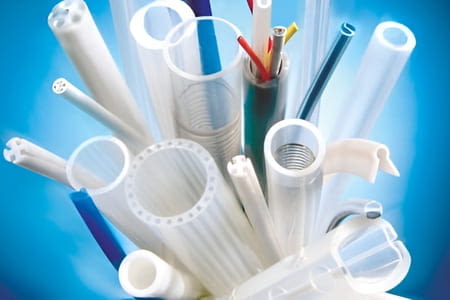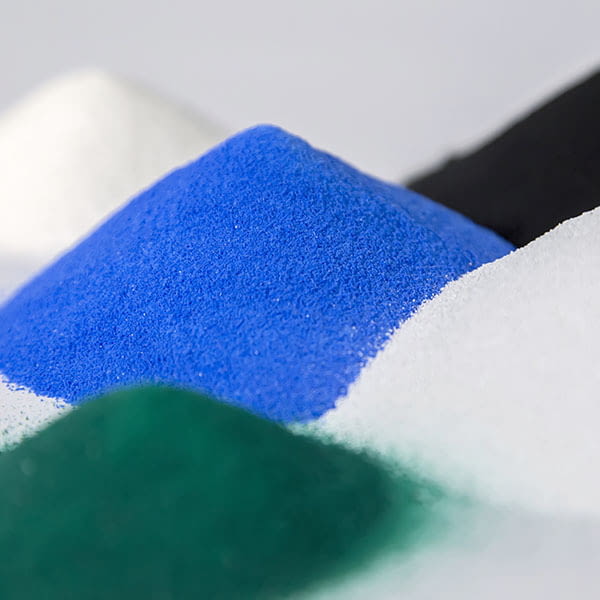
We don't all have technical knowledge on plastics, but sometimes we need to tell them apart in a practical and simple way.
For this reason, this new post can help you decide the type of plastic material you need for your applications, according to its physical characteristics.
Specifically, the classification according to the behaviour of this material in the presence of heat, which is divided into three main types:
THERMOPLASTICS (1)
THERMOSETS (2)
ELASTOMERS (3)
A quick and straightforward definition that differentiates them is that, after melting at high temperatures, moulding and cooling, a thermoplastic can be melted and moulded again.
A thermoset cannot; once melted and cooled with a defined shape, it would burn if heated again.
And an elastomer is an elastic plastic material that, after contact with heat and being deformed, tends to return to its initial state, rarely melting. (except in specific cases, which will be dealt with in another post)

Speaking in technical terms:
Thermoset plastics: when subjected to high temperatures, their molecules bind permanently. Thanks to this, they are highly durable, lightweight materials, and can be reinforced with glass fibre. They have high resistance to impact and chemical agents and can withstand extreme temperatures. Thermosets are infusible and insoluble polymers.
The molecules of the elastomers, called monomers, bind together in a disordered way, align when the material is stretched and return to their original state when released. Even when subjected to average temperatures, elastomers suffer degradation of their properties, which means they cannot be recycled with heat.
Thermoplastics are polymers with a high molecular weight, which, when in contact with heat (depending on the plastic material, there is a variation of behaviour with temperature), reach a homogeneous liquid state and can then go to a gaseous state – they can be melted.
Once cooled, the thermoplastic becomes a hard material.
At very cold temperatures, they become brittle and break.
All these properties are reversible when it comes into contact with heat again.
Due to its capacity for reuse and consequently recycling, thermoplastics today constitute 90% of all plastics used in the majority of industries. It is also important to know that, if it is reused over and again, its physical properties diminish, therefore its mechanical characteristics and degree of reuse are also affected.
It is interesting that, depending on the temperature to which it is subjected, the same polymer can go from being a hard and rigid material to a smooth and flexible plastic.
Notable properties of thermoplastics:
We differentiate between:
Thermoplastics for general use: around 80%, very economical and easy to process.
High-performance thermoplastics, which have special properties: greater mechanical strength, greater transparency or chemical resistance and the capacity to withstand high temperatures.
It is possible to find different types of thermoplastics that are used for specific applications, but they are used in the majority of industries.
Among the most used are: polyvinyl chloride (PVC), polycarbonate, polyethylene (PE), polyester, polyamide-Nylon®, Teflon®, polypropylene (PP), polystyrene (PS), polyethylene terephthalate (PET), acetal-POM-DELRIN®, etc.
This is just a brief look at the most important properties of thermoplastics. If you need further information on any of these aspects, see the engineering plastics on our website, or contact us.
For this reason, this new post can help you decide the type of plastic material you need for your applications, according to its physical characteristics.
Specifically, the classification according to the behaviour of this material in the presence of heat, which is divided into three main types:
THERMOPLASTICS (1)
THERMOSETS (2)
ELASTOMERS (3)
A quick and straightforward definition that differentiates them is that, after melting at high temperatures, moulding and cooling, a thermoplastic can be melted and moulded again.
A thermoset cannot; once melted and cooled with a defined shape, it would burn if heated again.
And an elastomer is an elastic plastic material that, after contact with heat and being deformed, tends to return to its initial state, rarely melting. (except in specific cases, which will be dealt with in another post)

Speaking in technical terms:
Thermoset plastics: when subjected to high temperatures, their molecules bind permanently. Thanks to this, they are highly durable, lightweight materials, and can be reinforced with glass fibre. They have high resistance to impact and chemical agents and can withstand extreme temperatures. Thermosets are infusible and insoluble polymers.
The molecules of the elastomers, called monomers, bind together in a disordered way, align when the material is stretched and return to their original state when released. Even when subjected to average temperatures, elastomers suffer degradation of their properties, which means they cannot be recycled with heat.
Thermoplastics are polymers with a high molecular weight, which, when in contact with heat (depending on the plastic material, there is a variation of behaviour with temperature), reach a homogeneous liquid state and can then go to a gaseous state – they can be melted.
Once cooled, the thermoplastic becomes a hard material.

At very cold temperatures, they become brittle and break.
All these properties are reversible when it comes into contact with heat again.
Due to its capacity for reuse and consequently recycling, thermoplastics today constitute 90% of all plastics used in the majority of industries. It is also important to know that, if it is reused over and again, its physical properties diminish, therefore its mechanical characteristics and degree of reuse are also affected.
It is interesting that, depending on the temperature to which it is subjected, the same polymer can go from being a hard and rigid material to a smooth and flexible plastic.
Notable properties of thermoplastics:
- They can be easily moulded
- They react on contact with some solvents and absorb them and, as a consequence, they swell, changing their state and properties
- They have plastic and elastic behaviour
- They are impact resistant
- Corrosion resistant
- They have electrical properties. Some thermoplastic polymers are insulating materials and others are the opposite, they have a useful thermal conductivity (for example acetal)
We differentiate between:
Thermoplastics for general use: around 80%, very economical and easy to process.
High-performance thermoplastics, which have special properties: greater mechanical strength, greater transparency or chemical resistance and the capacity to withstand high temperatures.
It is possible to find different types of thermoplastics that are used for specific applications, but they are used in the majority of industries.
Among the most used are: polyvinyl chloride (PVC), polycarbonate, polyethylene (PE), polyester, polyamide-Nylon®, Teflon®, polypropylene (PP), polystyrene (PS), polyethylene terephthalate (PET), acetal-POM-DELRIN®, etc.
This is just a brief look at the most important properties of thermoplastics. If you need further information on any of these aspects, see the engineering plastics on our website, or contact us.
We will be happy to help you.







